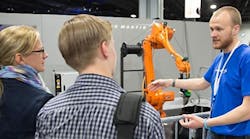Manufacturing Day celebrates modern manufacturing and is intended to inspire the next generation of manufacturers. However, the American manufacturing industry is facing an identity crisis that is hurting its ability to reinvigorate its ranks. A combination of factors are at play, including the need for newer skills created by the digitized manufacturing landscape, as well as the shift from a Baby Boomer economy to younger generations.
Although new technologies have significantly improved manufacturing processes, younger workers often associate manufacturing jobs with pollution, repetition and potentially dangerous work.
As a result, the manufacturing sector needs to articulate a new vision, one that requires investing in the resources and job training to enable a younger workforce to see a lasting and successful career in manufacturing. Here are some approaches that are showing promise:
Developing Training Programs
Researchers at the Urban Manufacturing Alliance, with support from Bank of America Merrill Lynch, surveyed and interviewed hundreds of manufacturers across six cities for its State of Urban Manufacturing (SUM) study. The research found that larger manufacturing firms mostly hired people referred by current employees and through services like online job boards. For manufacturing companies facing pressures to keep up with the consequences of the widening skills and labor gap, the most effective strategy has historically been to begin internally—a process that benefits from the development of robust in-house training and recruitment programs.
In their third manufacturing skills gap report, conducted by Deloitte and The Manufacturing Institute, Americans strongly believe that targeted programs are a valuable resource for driving new growth opportunities, with 67% citing internships and apprenticeship programs, and 62% of those surveyed identifying certification or degree programs as potentially effective. Many of these in-house programs can tap the in-depth expertise of senior employees before they transition into retirement.
Equipping all current and future employees with these resources is not only critical for addressing the talent shortage in the short-term, but it’s also a clear demonstration of a company’s investment in its employees, which helps attract and retain talent for long-term growth.
Partnering with Schools
Now, more than ever, investing time and resources into educating students should be considered a top priority, especially with students in the post-millennial generation who are approaching the ages of 16 to 20 and beginning to make career decisions.
A Deloitte/Manufacturing Institute report on public perception of manufacturing found that only 24% of Americans felt their local school system provided students with information about a career in manufacturing. To help ensure a skilled workforce of the future, organizations can partner with local high schools and colleges to redefine the perception of the industry and introduce students to the required technical skills before they enter the workforce.
Companies may benefit from presentations at job fairs, or from internship and apprenticeship opportunities to help dispel myths about the manufacturing industry. These programs offer hands-on experience without the full commitment of employment. Students get a better idea of what the job entails, while employers can identify strong job candidates.
Tapping into Non-Traditional Work Pools
As organizations rebuild their workplace cultures, manufacturing leaders can also address the current skills gap by turning to untapped populations such as refugees, immigrants or other non-traditional work pools. For example, Nehemiah Manufacturers creates new opportunities for individuals from disadvantaged communities by providing hands-on training in technical manufacturing and leaderships skills, leading them to build a sustainable career while supporting job fulfillment.
Other innovative recruitment initiatives include: Baltimore’s Second Chance, which trains individuals with criminal records and helps connect them with manufacturing jobs that work with deconstructed building materials; Detroit Kitchen Connect, which helps food manufacturers from refugee and immigrant communities get their products to market; the Jane Addams Resource Center in Chicago, which provides CNC, welding, and press brake training to low-income adults looking for employment; and Seattle Sewn, which provides training and job placement services for the apparel manufacturing sector.
The future success of manufacturing depends on a renewed commitment to the workforce, whether it’s through leveraging current employees and soon-to-be retirees, familiarizing students in the classroom with manufacturing industry opportunities or tapping into a non-traditional workforce.
Matthew B. Elliott is midwest region executive, business banking, Bank of America Merrill Lynch.




